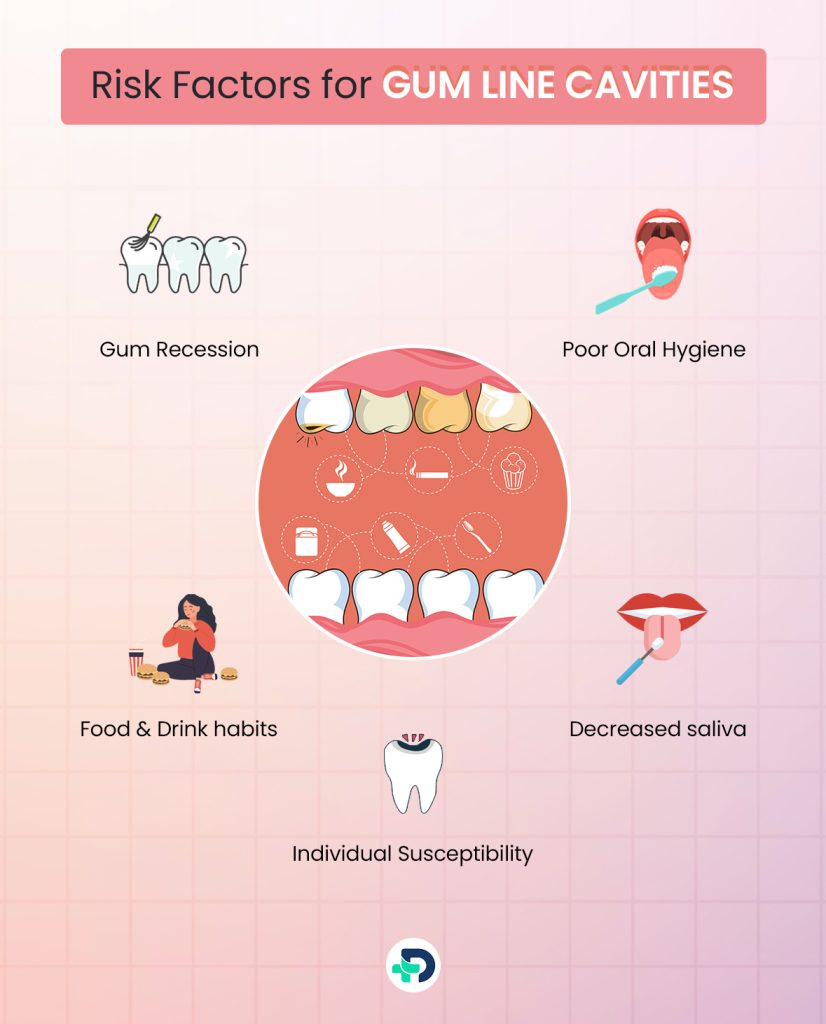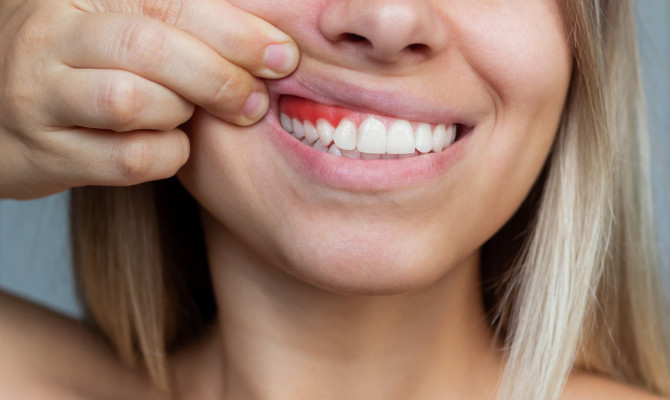Cavity at Gum Line Causes, Symptoms & Management

- Cavities
- 10 Oct 2023
Overview
Gum Line Cavities
Cavities are tiny voids or holes that form on the surface of the tooth. Cavities, also referred to as cavity formation or dental caries, are caused by a variety of factors, including dental plaque, frequent eating, drinking sugary drinks, and insufficient teeth cleaning. 3 Overview | Researched based study from Mayo Clinic Simply said, gum line cavities are holes that form on the side of the tooth, wherein the gums contact the tooth, as opposed to between teeth or in the molar’s pit. Exposed tooth roots are also related to gum line cavities. This occurs because gum disease has caused the gum tissue that normally covers the roots to retreat, leaving the root exposed and prone to decay. 5 Overview | Researched based study from Journal of Conservative Dentistry

Causes
What Causes Gum Line Cavities?
The beginning & development of cavities can be attributed to a variety of causes and conditions, such as
- Erosion (acid wear)
- Abrasion (hard brushing)
- Abfraction (incorrect bite creating stress fractures)
- Plaque accumulation along the gum line promotes tooth decay in this sensitive location.
Any of these factors, either separately or together, can promote cavity advancement after the outer layer of the crowns or roots has been compromised.
Stages
Stages of Gum Line Cavity Formation
Stage 1: Initial Wear & Tear
Plaque Build-Up:
- Cavities near the gum line can appear similarly to other kinds of cavities when plaque and germs in the mouth accumulate. ‘
- This bacterium generates acid, which erodes tooth enamel and leads to cavities.
- The regions along the gum line are just as likely to retain food particles, germs, and plaque as the groove and crevices in the molar are.
Abrasion:
- Cavities can develop as a result of abrasion, which is frequently brought on by vigorous tooth cleaning or routine use of abrasives (such as toothpicks or excessively abrasive toothpaste).
Abfraction:
- Abfraction is a process that happens as a result of biomechanical forces acting on the teeth, which frequently result from bad habits like clenching, grinding, or an improper bite.
- At the gum line, when the enamel is more fragile and brittle, these stresses might give rise to tiny cuts or lesions.
Erosion:
- The protective coatings of teeth are gradually worn down by repeated contact to acidic chemicals.
- Acidic compounds can be produced by an acidic diet, frequent vomiting, gastroesophageal reflux disease (GERD), or stomach acids. 1 Stages| Researched based study from Gum Disease Guide
Stage 2: Formation of Cavities
- The enamel or cementum on the tooth’s root or crown, respectively, are where the cavity first appears.
- You could see patches of demineralization or white spots.
- The dentin, a more delicate layer under the enamel or cementum, is reached when the cavity becomes deeper.
- There is a feeling of discomfort or sensitivity.
Stage 3: Advanced Decay
- The pulp of the tooth, which includes the tooth’s nerves and blood arteries, may be affected if the decaying process is allowed to continue.
- This stage frequently entails severe pain and infection.
- When germs invade the pulp chamber, an abscess can develop at the tooth’s root as a result of a buildup of pus.
- Advanced decay can cause edema, fever, and excruciating discomfort.
Stage 4: Serious Repercussions
- If nothing is done, the tooth’s structural integrity is seriously threatened, which increases the risk of cracks, fractures, or tooth shattering.
- Ultimately, tooth extraction may be necessary to stop future issues and infections due to the considerable decay and destruction. 1 Stages| Researched based study from Gum Disease Guide
Risk Factors

Risk Factors for Gum Line Cavities
These holes can develop as a result of several circumstances, including:
Gum Recession:
- Gum recession is responsible for gum line cavities in tooth roots.
- Aging, strenuous teeth cleaning, or periodontal illnesses can all contribute to this.
- The tooth’s root becomes exposed when the gums recede, leaving it susceptible to decay.
Poor Oral Hygiene:
- Plaque can build up at the gum line as a result of improper brushing and flossing teeth.
- Toxic bacteria found in plaque create acids, which cause tooth decay.
Food & Drink habits:
- Excessive consumption of sweet and acidic foods and beverages, particularly when the roots of the teeth are exposed, can hasten tooth decay.
Decreased saliva:
- Saliva serves as a natural cleaner and aids in neutralizing acids in dry mouth.
- The likelihood of gum line recession is increased by ailments or drugs that cause dry mouth.
Individual Susceptibility:
- Some persons may be susceptible genetically to acquiring gum line cavities, have worse enamel, or already have dental problems. 1 Risk Factors| Researched based study from Gum Disease Guide
Symptoms
Symptoms of Gum Line Cavities
Symptoms of gum line cavity depend on the size, severity, and where the cavity is located. While a cavity is developing, you may sometimes not even notice any symptoms at all.
As it spreads, it may cause the following signs and symptoms:
- Sensitive teeth
- Moderate to severe discomfort in teeth when consuming food that is cold, spicy, or sweet.
- Black, brown, or white stains
- Your teeth may have visible pits
- Toothache, discomfort, or severe pain, that appears for no obvious reason.
- When you bite down, it hurts. 3 Symptoms| Researched based study from Mayo Clinic
Treatment
Treatment of Gum Line Cavities
The specific reason determines how lesions at the gum line are repaired. Treatment options include:
Fillings:
- If keeping dental hygiene becomes difficult or you have tooth sensitivity because of exposing nerves, fillings may be a suitable option.
- Your dentist can match the color of your existing teeth, providing not just comfort but additionally an aesthetically beautiful finish.
Mouthguard:
- If you grind or clench the teeth while sleeping, the dentist may recommend a customized mouthguard to avoid further tooth deterioration.
Toothpaste:
- While it might not directly tackle cavities, using particular toothpaste formulations may lessen tooth sensitivity and abrasion, providing some relief.
Treatment For Gum Recession or Gum Disease:
- If gum illness or gum recession is increasing your risk of gum line cavities, it is critical to get treatment.
Fluoride treatment:
- This may be recommended by your dentist to assist remineralize the outer layers of teeth and prevent future decay.
Improved Oral Hygiene:
- Practicing proper oral hygiene can help to reduce the creation and advancement of cavities.
Changes in Diet:
- Reducing acidic and sweet foods in your diet can also help avoid additional decay. 1 Treatment| Researched based study from Gum Disease Guide
Prevention
How to Prevent Gum Line Cavities?
Brushing the teeth with toothpaste containing fluoride after eating or drinking at least twice a day, ideally after each meal. Floss or utilize an interdental cleaner to clean between the teeth.
Rinse your mouth with water:
- If your dentist feels you are at a greater risk for cavities, he or she may advise you that you utilize mouthwash containing fluoride.
Visit your dentist on a regular basis:
- Get professional dental cleanings and dental examinations done on a regular basis to help prevent or identify problems.
- The dentist may help you to plan the best treatment plan for you.
Take a look at dental sealants:
- A sealant is applied to occlusal surfaces of teeth to protect them.
- It seals food-collecting grooves, pits, fissures, and cracks, shielding tooth enamel from plaque accumulation and acid.
Consume some tap water:
- Fluoride is added to the majority of public water supplies, which helps in prevention of tooth decay.
- If you just drink bottled water that lacks fluoride, you will miss out on the fluoride benefits.
Avoid eating and drinking often:
- When you drink liquids other than water, the bacteria present in the oral cavity produces acids that can damage dental enamel.
- Eat food and drinks that are good for your teeth.
Eat tooth-friendly foods:
- Avoid foods that get stuck in the fissures of your teeth for longer duration.
- Do wash and gargle your teeth right after eating food.
- Fresh vegetables and fruits help to increase saliva flow, whereas unsweetened beverages like tea and coffee and sugar-free gum aid in the removal of food particles.
Fluoride treatments:
- Periodic treatments with fluoride may be prescribed by the dentist, especially when you do not get enough fluoride through fluoridated water or other sources.
- If the likelihood of tooth decay appears to be high, the dentist may also recommend customized trays that go over your teeth for applying prescription fluoride.
Look for medications with antimicrobial properties:
- If you suffer from a health problem that makes you more prone to cavities, your dentist may recommend antibacterial rinses or other therapies to help minimize harmful bacteria in your mouth.
Other treatments:
- Cavities can be prevented by eating xylitol-based gum, utilizing prescription fluoride, and using an antibacterial rinse. 2 Prevention | Researched based study from Cleveland Clinic
FAQs
Frequently Asked Questions About Gum Line Cavities
Q. Can gum line cavities be reversed?
- In most cases, reversing a gum line cavity is only possible in the early stages of decay.
- It may be possible to halt the spread of the decay and restore the minerals that have been lost from the tooth if your dentist finds a cavity during the initial stage of demineralization.
- However, for treatment to work, the cavity must be above the gum line and must not have expanded below it or affected the tooth’s root. 1 FAQs| Researched based study from Gum Disease Guide
Q. How long do gum line fillings last?
- Dental fillings cannot last forever and must be changed.
- If a filling lasts 10 years, it is deemed successful.
- This is determined by your nutrition, oral hygiene, overall pace of decay, and heredity, among other factors. 4 FAQs | Researched based study from National Institutes of Health
Q. What does a gum cavity look like?
- Gum line cavities include those that develop on the lingual or buccal surfaces of teeth.
- Gum line cavities are traditionally classed as carious or non-carious based on its genesis.
- Abrasion, erosion, and abfraction are the three types of non-carious cervical lesions. 5FAQs | Researched based study from Journal of Conservative Dentistry
Conclusion
Gum Line Cavities – Early Dental Intervention is Necessary
- Protecting the gum line, the essential junction where the gums and teeth meet is often overlooked yet crucial in sustaining oral health.
- Gum line cavities, while less visible, offer a major danger.
- These cavities, which are caused mostly by poor dental hygiene, eating habits, and sometimes hereditary factors, appear as symptoms such as tooth soreness and sensitivity.
- Early measures, such as improved dental hygiene and dietary modifications, as well as prospective treatments such as fillings and orthodontic modifications, may avoid additional decaying and even reverse early-stage cavities.
- As a result, attention and fast treatment are critical in limiting the risks associated with gum line cavities and ensuring a healthy and bright smile for years to come. 1 Conclusion| Researched based study from Gum Disease Guide
Any feedback on this article?
 This Articles content was accurate
This Articles content was accurate Very Informative Article
Very Informative Article I have a question or a comment
I have a question or a comment
 This article contains inaccurate content
This article contains inaccurate content This article was not helpful
This article was not helpful I have a question or a comment
I have a question or a comment
We appreciate your helpful feedback!
Checkout our social pages
References
-
Gum Disease Guide
Stages | Risk factors | Treatment | FAQs | Conclusion
-
Cleveland Clinic
Prevention
-
Mayo Clinic
Overview | Symptoms
-
National Institutes of Health
FAQs
-
Journal of Conservative Dentistry
Overview | FAQs



































